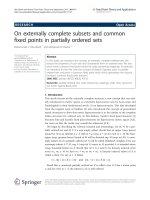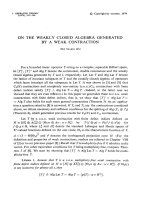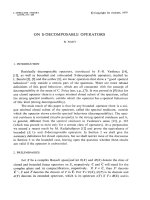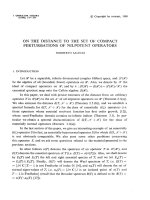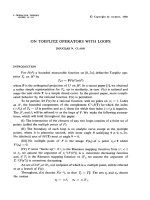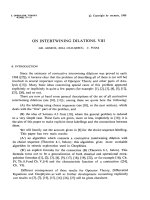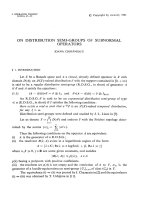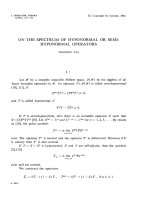Báo cáo toán học: " On cubic planar hypohamiltonian and hypotraceable graph" pptx
Bạn đang xem bản rút gọn của tài liệu. Xem và tải ngay bản đầy đủ của tài liệu tại đây (153.38 KB, 11 trang )
On cubic planar hypohamiltonian
and hypotraceable graphs
Makoto Araya
Department of Computer Science
Shizuoka University, Hamamatsu 432-8011, Japan
G´abor Wiener
Department of Computer Science and Information Theory
Budapest University of Technology and Economics
1117 Budapest, Magyar tud´osok k¨or´utja 2.
Submitted: Aug 4, 2009; Accepted: Apr 5, 2011; Published: Apr 14, 2011
Mathematics Subject Classification: 05C10, 05C38, 05C45
Abstract
We present a cubic planar hypohamiltonian graph on 70 vertices, improving the
best known b ound of 94 by Thomassen and derive some consequ ences concerning
longest paths and cycles of planar 3-connected graphs. We also show that cubic
planar hypohamiltonian graphs on n vertices exist for every even number n ≥ 86
and that cubic planar hypotraceable graphs exist on n vertices for every even number
n ≥ 356, settling an open question of Holton and Sheehan.
1 Introduction
Hamiltonian properties of planar cubic gra phs have been investigated extensively since
Tait’s attempt to prove the four color conjecture based on the proposition that every
3-connected planar cubic graph has a Hamiltonian cycle. This proposition was disproved
by Tutte [17] in 1946. However, until 1968, when Grinberg [4] proved a simple, yet very
useful theorem, such graphs were quite difficult t o find.
the electronic journal of combinatorics 18 (2011), #P85 1
Theorem 1.1. (Grinberg, 1968)
Suppose a plane graph has a Hamiltonian cycle, such that there are f
i
i-gons in the exterior
of the Hamiltonian cycle and f
′
i
i-gons in the interior of the Hamiltonian cycle. Then
i
(i − 2)(f
i
− f
′
i
) = 0. (1)
The theorem can be used to create non-hamiltonian planar cubic graphs: suppose for
example that all but one faces of a plane graph have degree congruent to 2 modulo 3,
then (1) clearly cannot hold, so the g r aph cannot be Hamiltonian. Since 1968, several
non-hamiltonian 3-connected planar cubic graphs have been found, the smallest of them is
the Barnette-Bos´ak- L ederberg graph on 38 vertices [2], [10], see also [5]. In 1986, Holton
and McKay [7] ( extending the results of many researchers) showed that there exists no
3-connected planar non-hamiltonian cubic g raph on fewer vertices.
A g raph G is hypohamiltonian (resp. hypotraceable) if it is not Hamiltonian (resp.
traceable) but every vertex-deleted subgraph of G is Hamiltonian (resp. traceable). The
study of hypohamiltonian graphs started with the paper of Sousselier [9] in 1963 and since
then hypohamiltonian graphs were extensively studied by many authors, see for example
the survey by Holton and Sheehan [8] and the papers [12], [13], [14], [15], [1 6], [3], [21].
Chv´atal [3] raised the question in 1973 whether there exists a cubic planar hypohamil-
tonian g r aph. This was answered by Thomassen [16], who found a sequence of such graphs
on 94 + 4m vertices for every integer m ≥ 0 in 1981. However, the question whether there
exist smaller cubic hypohamiltonian graphs and whether there exists a po sitive integer N ,
such that for every integ er n ≥ N there exists a cubic planar hypohamiltonian graph on n
vertices remained open (see [8]). Fro m the results of Aldred et al. [1] follows that there is
no cubic planar hypohamiltonian graph on 42 or fewer vertices. Here we present a cubic
planar hypohamiltonian graph on 70 vertices. Using the method of Thomassen for creat-
ing an n + 4 vertex cubic hypohamiltonian graph from an n vertex cubic hypo hamiltonian
graph [16] this also shows that cubic planar hypohamiltonian graphs on 70 + 4m vertices
exist for every even integer m ≥ 0. Since 70 ≡ 94 (mod 4), this is not enough to answer
the second open question, however we also give a cubic planar hypohamiltonian graph on
88 vertices, which shows that cubic planar hypohamiltonian graphs on n vertices exist
for every even number n ≥ 8 6. Using our g r aphs on 70 and 88 vertices and another con-
struction method of Thomassen [12], we can also show that a cubic planar hypotraceable
graph exists on 340 vertices and on n vertices for every even number n ≥ 356.
T. Zamfirescu [21] denoted the smallest number of vertices of a planar k-connected
graph, in which every j vertices are omitted by some longest cycle (path) by C
j
k
(P
j
k
).
The best known bounds on the numbers C
2
3
and P
2
3
are also improved using our 70-vertex
graph.
We will refer to an edge between vertices a and b as edge (a, b) and a cycle through
the vertices a
1
, a
2
, . . . , a
k
as cycle (a
1
, a
2
, . . . , a
k
). We use the shorthand not ation G − v
for the graph obtained from G by deleting the vertex v.
the electronic journal of combinatorics 18 (2011), #P85 2
2 Cubic planar hypohamiltonian graphs on 70 and
88 vertices
In this section we present our cubic planar hypohamiltonian graphs on 70 and 88 vertices.
It is worth mentioning that there exists no cubic planar hypohamiltonian graph on 42 or
fewer vertices, by the results of Aldred et al. [1]. They showed that every 3-connected,
cyclically 4-connected cubic planar graph has at least 42 vertices and presented all such
graphs on exactly 42 vertices. Since hypohamiltonian graphs are easily seen to be 3-
connected and cyclically 4-connected, they must have at least 42 vertices in the cubic
case. Moreover, all 42-vertex graphs presented in [1] have exactly one face with a degree
not congruent to 2 modulo 3, and it is easy to see that cubic graphs with this property
cannot be hypohamiltonian, as was observed by Thomassen [12]. The size of the smallest
cubic planar hypohamiltonian gr aph is therefore at least 44 and at most 70. The next
claims (that are extensio ns of the observation of Thomassen) may help to obtain a better
lower bound. Let us denote the number of edges of a face T by d(T ) a nd for t he sake of
simplicity let us call a face F an i-face (i = 0, 1, 2), if d(F ) ≡ i (mod 3) a nd call the 0-
and 1-faces together non-2-faces.
Claim 2.1. A cubic planar hypohamiltonian graph has at least three non-2-faces.
Proof. Let D be an arbitrary cubic planar hypohamiltonian gr aph. If D has only 2-faces,
then the deletion of any vertex gives a graph D
′
with exactly one non-2-face, so D
′
is not
Hamiltonian, a contradiction. D cannot have exactly one non-2-face by the observation
of Thomassen [12]. So let us assume that D has two non-2-faces A and B. It is easy to
see that both A and B should be 0-faces, because the deletion of a vertex that is in one
1-face and two 2-faces gives a graph with exactly one non-2-face. Now the deletion of a
vertex not in any of the 0-faces, but adjacent to a vertex that is in exactly one of the
0-faces gives a graph with exactly three 0-fa ces, o f which two have two common edges.
These cannot be on the same side o f a Hamiltonian cycle, therefore (1 ) cannot be satisfied,
which finishes the proof. ✷
The following claim can be proved similarly.
Claim 2.2. If a cubic planar hypohamiltonian graph has exactly three non-2-faces, then
the three non-2-faces do not have a common vertex, moreover two 1-faces or a 1-face and
a 0-face cannot be adjacent.
Now let us t urn our attention to the cubic planar hypohamiltonia n graphs G and H
that can be seen in Figure 1 and Figure 2, respectively.
Theorem 2.3. G and H are cubic planar hypohamiltonian graphs.
Proof. Both G and H are obviously cubic and planar. Both have one face of degree 4,
and four faces o f degree 7, such that the face of degree 4 is adjacent to all faces of degree
7 and the degrees of the other faces are congruent to 2 modulo 3. By Proposition 2.1. of
the electronic journal of combinatorics 18 (2011), #P85 3
Figure 1: The cubic planar hypohamiltonian graph G on 70 vertices
Figure 2: The cubic planar hypohamiltonian graph H on 88 vertices
the electronic journal of combinatorics 18 (2011), #P85 4
[16], G and H are non-hamiltonian (t he proof is quite easy using Grinberg’s theorem: in
order to satisfy (1) modulo 3, a Hamiltonian cycle should separate one of the five faces of
degree 4 or 7 f rom the others, which is impossible in the case of G and H).
Now it remains to show that every vertex-deleted subgraph of G and H is Hamiltonian.
Since G is centrally symmetric, we have to check 35 cases. H has more symmetries, thus
we have to check only 14 cases. The Hamiltonian cycles of the vertex-deleted subgraphs
of G and H are presented in the last section, on Figures 3, 4, 5 and on Figure 6. ✷
3 Corollaries
The most important corolla ry is the existence of cubic planar hypohamiltonian graphs on
n vertices fo r every even number n ≥ 86. This settles an open question in [8 ].
Corollary 3.1. There exists a cubic planar hypohamiltonian graph on n vertices for every
even number n ≥ 86.
Proof. The proof is quite obvious using a method of Thomassen [16]. Let T be a cubic
planar hypohamiltonian graph on n vertices having a 4-cycle (a, b, c, d). The graph T
′
ob-
tained from T by deleting the edges (a, b) and (c, d) and adding a new 4-cycle (a
′
, b
′
, c
′
, d
′
)
and the edges (a, a
′
), (b, b
′
), (c, c
′
), (d, d
′
) to T . Now it is easy to see that T
′
is also a
cubic planar hypohamiltonian graph o n n + 4 vertices having a 4-cycle. By applying this
operation iteratively on the graphs G and H we obtain cubic planar hypohamiltonian
graphs on n vertices for every even number n ≥ 86. ✷
Using another construction of Thomassen [14] a similar corollary for hypotraceable
graphs can also be proved.
Corollary 3.2. There exists a cubic planar hypotraceable graph on 340 vertices and on n
vertices for every even number n ≥ 356.
Proof. We use a construction of Thomassen [14]. Let T
1
, T
2
, T
3
, T
4
, T
5
be cubic planar
hypohamiltonian graphs and let x
i
and y
i
be adjacent vertices of T
i
(i = 1, 2, 3, 4, 5). Let
furthermore the neighbours of x
i
(resp. y
i
), other than y
i
(resp. x
i
) be a
i
and b
i
(resp.
c
i
and d
i
). Consider the disjoint union of the graphs T
i
− {x
i
, y
i
} and add to this graph
the edges (c
1
, a
2
), (c
2
, a
3
), (c
3
, a
4
), (c
4
, a
5
), (c
5
, a
1
) and the edges (d
1
, b
2
), (d
2
, b
3
), (d
3
, b
4
),
(d
4
, b
5
), (d
5
, b
1
). Now the resulting graph T is easily seen to be planar a nd cubic and by
Lemma 3.1. of [14], it is also hypotraceable. If we choose each T
i
to be isomorphic with
G, then we obtain a cubic planar hypotraceable gr aph on 340 vertices. To obtain a cubic
planar hypo tr aceable graph on 2k vertices for any k ≥ 178 we just have to change T
1
in
this construction to a cubic planar hypohamiltonian graph on 2k − 2 70 vertices (such a
graph exists by Corollary 3.1, since 2k − 270 ≥ 86). ✷
The next corollaries concern planar 3-connected graphs, in which every two vertices or
edges are omitted by some longest cycle or path. First we improve a theorem of Schauerte
and C. Zamfirescu. In [11] they showed (using a computer) that for any pair of edges e, f
the electronic journal of combinatorics 18 (2011), #P85 5
there exists a longest cycle in Thomassen’s 94-vertex cubic planar hypohamiltonian graph
[16] avoiding e and f. Using this observation and a method of T. Za mfirescu [21] they
proved that there exists a cubic planar 3-connected graph on 8742 vertices, such that any
pair of vertices is missed by a longest cycle.
The same property can also be checked easily for g raph G by a computer, i.e. using a
software like Mathematica or Maple.
Proposition 3.3. Let e and f be arbitrary edges of G. Then there exists a longest cycle
in G that does not contain e and f.
Corollary 3.4. There exists a cubic planar 3-connected graph on 4830 vertices, such that
any pair of vertices is missed by a longest cycle.
Proof. We create a graph with t he desired properties using a method of T. Zamfirescu
[21]. Consider the 70-vertex cubic planar hypohamiltonian graph G, and let V (G) =
{a
1
, a
2
, . . . , a
70
}. Let furthermore G
′
be the graph obtained from G by t he deletion of a
70
and assume that the neighbours of a
70
are a
1
, a
2
, and a
3
in G. Now consider the graph
Z consisting of 70 copies of G
′
: G
′
1
, G
′
2
, . . . , G
′
70
, such that we draw an edge between two
copies G
′
i
and G
′
j
if and only if a
i
and a
j
are adjacent in G. These additional edges are
always drawn between two vertices having degree 2 in the copies (that is, copies of a
1
, a
2
,
or a
3
). It is easy to see that Z is a cubic planar 3- connected graph on 69 · 70 = 4830
vertices. By Theorem 2.3, Proposition 3.3, and a theorem of T. Zamfirescu [2 1], any pair
of vertices is missed by a longest cycle in Z. For completeness’ sake we reformulate here
the proof of Zamfirescu. Since G is hypohamiltonian, it is easy to see that the longest
cycle of Z has length 68 · 69 = 4692 (one copy and one vertex of every other copy must
be avo ided, otherwise G would be Hamiltonian, and a cycle of length 4692 is easy to find
using the hypohamiltonicity of G). If the two vertices x and y we would like to avoid by a
longest cycle are in the same copy, then simply consider a longest cycle avoiding this copy
completely. Thus we may assume that x and y are in different copies. It is easy to see that
there is a Hamiltonian path between two of the vertices a
1
, a
2
, a
3
in every vertex-deleted
subgraph of G
′
. Let x
′
(y
′
) be that copy of a
1
, a
2
, or a
3
that is not the endvertex of such
a Hamiltonian path if we delete x (y). Now let us delete x, y, and one vertex from every
other copy of G
′
from Z. Let us delete furthermore the additional edges incident to x
′
and
y
′
. By Theorem 2.3 and Propo sition 3.3 there is a cycle of length 4692 in the remaining
graph, which proves the coro llar y. ✷
The following definition is due to T. Zamfirescu [20].
Definition 3.5. C
j
k
(resp. P
j
k
) is the smallest number of vertices of a planar k-connected
graph, in which every j vertices are omitted by some longest cycle (resp. path).
T. Zamfirescu gave several bounds on these numbers in [21], of which the upper bounds
on C
2
3
and P
2
3
were improved in [6] (see also [18]), [22], and [19]. The currently known
best upper bounds a re C
2
3
≤ 3701, P
2
3
≤ 14694. Using our graph G we can derive even
better bounds. For the proof we use the same method of T. Zamfirescu [21] as was used
in [6], [22], a nd [19].
the electronic journal of combinatorics 18 (2011), #P85 6
Corollary 3.6. C
2
3
≤ 2765, P
2
3
≤ 10902.
Proof. The method is similar to the one used in Corollary 3.4. Let Γ be the planar
hypohamiltonian gra ph on 42 vertices given in [19]. The graph Γ
′
is obtained by deleting
any vertex of degree 3 from Γ. Now consider the graph Y consisting of 70 copies of Γ
′
:
Γ
′
1
, Γ
′
2
, . . . , Γ
′
70
, such that we draw an edge between two copies Γ
′
i
and Γ
′
j
if and only if a
i
and a
j
are adjacent in G. These additional edges are always drawn between two vertices
that are copies of the neighbours of the deleted vertex. It is easy to see that Y is a planar
3-connected graph on 41 · 70 = 2870 vertices. From the hypohamiltonicity of Γ and G,
Proposition 3.3, and the mentioned theorem of Zamfirescu [21], any pair of vertices is
missed by a longest cycle in Y . None of these properties are lost if we now contract the
additional edges of Y (see [21 ]), obtaining a graph on 41 · 70 − 10 5 = 2765 vertices, which
proves the first upper bound.
The second bound is proved similar ly. First we t ake four copies of G
′
and an additional
edge between any two copies (these edges are drawn between copies of a
1
, a
2
, or a
3
again).
Denote t he graph obtained in t his way by X. Now we execute the same procedure as
above, but this time we put the copies of Γ
′
into the graph X and then contract the
additional edges to obtain a 3-connected planar graph, where every pair of vertices is
missed by a longest path in 69 · 4 · 41 − (( 105 − 3) · 4 + 6) = 10902 vertices (see [21]). ✷
4 Hamiltonian cycles of the vertex-dele t ed subgraphs
of G and H
In this section we present the Hamiltonian cycles of the vertex-deleted subgraphs of G
and H. G is centrally symmetric, so we have to check 35 cases (Figures 3, 4, and 5). H
has more symmetries, thus we have to check 14 cases (Figure 6).
Figure 3: Hamiltonian cycles of the vertex-deleted subgraphs of G
the electronic journal of combinatorics 18 (2011), #P85 7
Figure 4: Hamiltonian cycles of the vertex- deleted subgraphs of G (continued)
the electronic journal of combinatorics 18 (2011), #P85 8
Figure 5: Hamiltonian cycles of the vertex- deleted subgraphs of G (continued)
Figure 6: Hamiltonian cycles of the vertex-deleted subgraphs of H
the electronic journal of combinatorics 18 (2011), #P85 9
Acknowledgement
The authors would like to thank the Suzuki Foundation for their generous support. Re-
search of G´abor Wiener was partially supported by the Hungarian Natio na l Research
Fund and by the National Office for Research and Technology (Grant Number OTKA
67651).
References
[1] Aldred, R. E. L., Bau, S., Holton, D. A., McKay, B. D.: Nonhamiltonian 3-connected
cubic planar graphs. SIAM J. Disc. Math. 13, 25–32. (2000)
[2] Bos´ak, J.: Hamiltonian lines in cubic graphs. Theory of Graphs (Internat. Sympos.,
Rome, 1 966) Go r don a nd Breach, New York; Dunod, Paris, 35–46. (1967)
[3] Chv´atal, V.: Flip-flops in hypohamiltonian gr aphs. Can. Math. Bull. 16, 33–41.
(1973)
[4] Grinberg, E. J.: Plane homogeneous graphs of degree three without Hamiltonian
circuits. Latvian Math. Yearbook, Izdat. Zinatne, Riga 4, 51–58. (1968) (in Russian)
[5] Gr¨unbaum, B.: Convex Po lytopes. Jo hn Wiley and Sons, New York (196 7)
[6] Hatzel, W.: Ein planarer hypohamiltonischer Graph mit 57 Knoten. Math. Ann. 243,
213–216. (1979)
[7] Holton, D. A., McKay, B. D.: The smallest non-hamiltonian 3-connected cubic planar
graphs have 38 vertices. J. Combinatorial Theory (B) 45, 315–319. (1988)
[8] Holton, D. A., Sheehan, J.: Hypohamiltonian gra phs. in: The Petersen Graph, Cam-
bridge University Press, New York, 1993.
[9] Sousselier, R.: Probl`eme No. 29: Le Cercle des Irascibles. Revue Fran¸caise de
Recherches Op´erationelle 7, 405–406. (1963)
[10] Lederberg, J.: Systematics of organic molecules, graph theor y and Ha miltonian cir-
cuits, Instrumentation Research Laboratory Report, no. 1040, Stanford University,
Stanford, Calif., 1144 (1966)
[11] Schauerte, B., Z amfirescu, C. T.: Regular graphs in which every pair of points is
missed by some longest cycle. An. Univ. Craiova , Ser. Mat. Inf. 33, 154–173. (2006 )
[12] Thomassen, C.: Hypohamiltonian and hypot raceable graphs. Discrete Mathematics
9, 91–96. (1974)
[13] Thomassen, C.: On hypohamiltonian graphs. Discrete Mathematics 10, 383–390.
(1974)
[14] Thomassen, C.: Planar and infinite hypohamiltonian and hypotraceable graphs. Dis-
crete Mathematics 14, 377–389. (1976)
[15] Thomassen, C.: Hypohamiltonian graphs and digraphs. in: Theory and Applications
of Graphs, Lecture Notes in Mathematics No. 642, Springer, Berlin, 557–571. (1978)
the electronic journal of combinatorics 18 (2011), #P85 10
[16] Thomassen, C.: Planar cubic hypohamiltonian and hypotraceable graphs. J. Comb.
Theory B 30, 36–4 4. (1981)
[17] Tutte, W. T.: On hamiltonian circuits. J. London Math. Soc. 21, 98–101. (1946)
[18] Voss, H. J.: Cycles and bridges in graphs. Kluwer Academic Publishers, Dordrecht,
1990.
[19] Wiener, G., Araya, M.: On planar hypohamiltonian graphs. J. Graph Theory 67,
55–68. (2011)
[20] Zamfirescu, T.: A two-connected planar graph without concurrent longest pa t hs. J.
Comb. Theory B 13, 116–121. (1972)
[21] Zamfirescu, T.: On longest paths and circuits in graphs. Ma th. Scand. 38, 211–239.
(1976)
[22] Zamfirescu, C., Zamfirescu, T.: A planar hypohamiltonian graph with 48 vertices. J.
Graph Theory 55, 116–121. (2007)
the electronic journal of combinatorics 18 (2011), #P85 11
